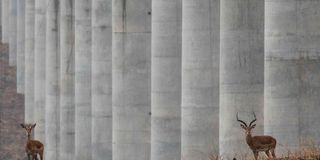Pain for tourists as KWS, Kenya Railways implement increased charges

What you need to know:
- The Kenya Wildlife Service (KWS) announced a significant hike in park entry fees, with the highest increase affecting Nairobi National Park, a favourite among city dwellers and foreign tourists alike.
- Kenya is, alongside South Africa and Tanzania, ranked among the most visited countries in sub-Saharan Africa.
Visitors will, from January 2024, have to part with more to access Kenya’s vast parks.
The Kenya Wildlife Service (KWS) announced a significant hike in park entry fees, with the highest increase affecting Nairobi National Park, a favourite among city dwellers and foreign tourists alike.
Simultaneously, Kenya Railways has announced a 50 percent fare increase for passengers travelling from Nairobi to Mombasa via the Standard Gauge Railway (SGR), effective from January 1, 2024.
Two-fold increase in expenses
This means individuals utilising the SGR to access Tsavo East and Tsavo West National Parks will experience a two-fold increase in expenses, coinciding with the fare hike implemented by the SGR.
Kenya Railways management said passengers travelling from Nairobi to Mombasa will pay Ksh1,500 - $9.95 (economy class) and Ksh4,500 - $29.86 (first class), up from the current Ksh1,000 - $6.64 (economy class) and Ksh3,000 - $19.91 (first class).
Those opting for Inter County will pay first class; Nairobi to Mariakani (Ksh4,310 - $28.60), Athi River to Mombasa (Ksh4,340 - $28.80), Emali to Mombasa (Ksh3,350 - $22,23), and Voi to Mombasa (Ksh1,320 - $8.76). Economy class; Nairobi to Mariakani (Ksh1,500 - $9.95), Athi River to Mombasa (Ksh1,430 - $9.49), Emali to Mombasa (Ksh1,100 - $7.30), and Voi to Mombasa (Ksh440 - $2.92).
Changes in the Energy and Petroleum sector
Kenya Railways explained in a statement that the increase is informed by changes in the energy and petroleum sector where prices of fuel have significantly increased, thus “affecting the cost of our operations.”
This adjustment is expected to impact the budgets of both locals and tourists seeking to explore these parks, creating a notable financial challenge for those intending to visit these natural attractions.
Potential loss of business
Tourism industry representatives have warned that Kenya faces a potential loss of business following the decision by the KWS to triple entry fees for parks.
The Diani Hospitality Owners Association Chairman, Mohammed Hersi, expressed concern that the increased park fees and the added complexity of paying at park entrances could discourage tour operators from promoting packages that include visits to national and marine parks.
"The revised prices surpass those of our neighbouring competitors like Tanzania, Rwanda, and South Africa. This disparity may divert tourists to these countries, where similar packages are available at more affordable rates. This poses a significant obstacle to the growth of our tourism sector and overall economic progress, Mr Hersi said."
According to KWS, the fees are a result of a comprehensive analysis of the feedback gathered during forums conducted between January 30 and February 23, 2023.
The charges are for camping, conference facilities, and vehicles entering the parks. KWS oversees 25 terrestrial national parks, 29 terrestrial national reserves, four marine national parks, six marine national reserves, six national wildlife sanctuaries, and three captive wildlife management facilities.
If one chooses to visit the parks during the high season from July to March, East African Community (EAC) and resident adults will face a substantial rise in fees, now set at Sh2,000, previously Sh430.
International visitors
International visitors during this period will encounter charges of $50 (Sh7,167) for visitors from Africa and $100 (Sh14,335) for those from other international destinations.
Even during the low season from April to June, the fees for EAC and resident adults will remain at Sh2,000 for Nairobi National Park. International visitors, however, will experience a noticeable increase, paying $20 (Sh2,867) for visitors from Africa and $100 (Sh14,335) for those from other international destinations.
At premium facilities such as Amboseli and Lake Nakuru National Park, fees for EAC and resident adults will be Sh1,000 during the high season, with visitors from Africa and international destinations paying $50 (Sh7,167) and $100 (Sh14,335) respectively.
During the low season, EAC and resident adults will be charged Sh800, while visitors from Africa and the rest of the world will pay $35 (Sh5,017) and $80 (Sh11,468) respectively.
Previously, KWS charged Kenyan adults Sh430 and children Sh215 for park visits. Non-Kenyan adults paid $43 (Sh6,164), and children/students paid $22 (Sh3,153).
SGR fare adjustment
The SGR fare adjustment also extends to passengers using other railway services, including the Nairobi commuter rail service and the Kisumu and Nanyuki safari trains.
Children aged three to 11, travelling with adults, will pay half the price, while those aged above 11 will pay full adult fare.
Kenya is, alongside South Africa and Tanzania, ranked among the most visited countries in sub-Saharan Africa.
As a result, tourism receipts, are, alongside remittances from Kenyans living abroad and the sale of tea, ranked the country’s highest income earner.





